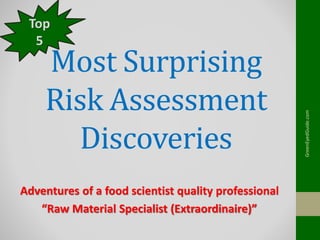Top 5 Most Surprising Risk Assessment Discoveries: Day in the Life of a Food Scientist QA Professional
- 1. Most Surprising Risk Assessment Discoveries Adventures of a food scientist quality professional ŌĆ£Raw Material Specialist (Extraordinaire)ŌĆØ Top 5 GreenEyedGuide.com
- 2. #1:Psyllium Husk andbugs GreenEyedGuide.com Source: http://www.perfectdump.com/buy-organic-fiber-supplements/ (no kidding) Most Surprising Risk Assessment Discoveries
- 3. GreenEyedGuide.com For powdered psyllium husk, up to 400 insect parts per 25g are acceptable For whole psyllium husk, itŌĆÖs not more than 100 insect fragments Most Surprising Risk Assessment Discoveries SOURCE: US PHARMACOPEIA Monograph http://www.pharmacopeia.cn/v29240/usp29nf24s0_m71745.html #1:Psyllium Husk andbugs
- 4. GreenEyedGuide.com No reason to panic ŌĆō these bugs are not known to cause any harm, this is just an accepted and somewhat-natural part of the plant Most Surprising Risk Assessment Discoveries #1:Psyllium Husk andbugs
- 5. GreenEyedGuide.com Most Surprising Risk Assessment Discoveries SOURCE: ŌĆ£Chemicals in my FoodŌĆØ Tumblr ŌĆō Professor John Coupland http://johncoupland.tumblr.com/post/95874982501/your-vegetable-juice- is-not-vegetarian-and-you
- 6. #2: Moringa Leaf Powder andsoap GreenEyedGuide.com Most Surprising Risk Assessment Discoveries Source: http://eol.org/pages/486251/details Source: http://www.moringapowder.com/
- 7. #2: Moringa Leaf Powder andsoap GreenEyedGuide.com Most Surprising Risk Assessment Discoveries SOURCE: Effcacy of Moringa oleifera leaf powder as a hand-washing product: a crossover controlled study among healthy volunteers. http://www.ncbi.nlm.nih.gov/pubmed/24528477
- 8. #2: Moringa Leaf Powder andsoap GreenEyedGuide.com 4 grams wet or dry Moringa Leaf powder was as effective as non- medicated soap for hand-washing and 10-log reduction of non- pathogenic E coli Most Surprising Risk Assessment Discoveries SOURCE: Effcacy of Moringa oleifera leaf powder as a hand-washing product: a crossover controlled study among healthy volunteers. http://www.ncbi.nlm.nih.gov/pubmed/24528477
- 9. #3: Acai andChagas GreenEyedGuide.com Most Surprising Risk Assessment Discoveries SOURCE: http://www.cloudforest.com/cafe/gardening/the- acai-palm-t4378.html SOURCE: http://dmt- sbi3u.wikispaces.com/Acai+Palm+Tree
- 10. #3: Acai andChagas GreenEyedGuide.com SOURCES: http://www.cdc.gov/parasites/chagas/ http://www.who.int/mediacentre/factsheets/fs340/en/ Pereira et al. ChagasŌĆÖ Disease as a Foodborne Illness Journal of Food Protection, Vol. 72, No. 2, 2009, Pages 441ŌĆō446 Most Surprising Risk Assessment Discoveries ŌĆó Chagas disease is caused by the parasite Trypanosoma cruzi ŌĆó Recent outbreaks of Chagas in Brazil have been associated with acai juice ŌĆó Transmission of the parasite occurs through infected triatomine bugs, mixed in with acai fruit as it is ground into pulp
- 11. #3: Acai andChagas GreenEyedGuide.com Most Surprising Risk Assessment Discoveries No reason to panic ŌĆō just make sure the acai juice is pasteurized
- 12. #4: Ginkgo Biloba ItŌĆÖsnotwhatyou think! GreenEyedGuide.com Most Surprising Risk Assessment Discoveries
- 13. #4: Ginkgo Biloba ItŌĆÖsnotwhatyou think! GreenEyedGuide.com Adulteration is high due to consumer demand 1 g extract requires 50 g dried leaf more demand than supply encourages adulteration Most Surprising Risk Assessment Discoveries
- 14. #4: Ginkgo Biloba ItŌĆÖsnotwhatyou think! GreenEyedGuide.com The Good News: Adulteration forces the science community to develop better testing methods, but consumers should beware. Most Surprising Risk Assessment Discoveries Ginkgo adulteration ŌĆśvery widespreadŌĆÖ, say industry experts, so why is awareness low? By Stephen DANIELLS, 05-Aug-2013 Adulteration of Ginkgo biloba is ŌĆśvery widespreadŌĆÖ, according to industry sources, but as the adulteration becomes more sophisticated new methods are emerging to help industry ensure the quality of this key herbal. http://www.nutraingredients-usa.com/Markets/Ginkgo-adulteration-very-widespread-say-industry- experts-so-why-is-awareness-low
- 15. #5: Leafy Greens and Grasses GreenEyedGuide.com For some ingredients, the literature search doesnŌĆÖt turn up anything odd, but the lab test results do! 3 examples Most Surprising Risk Assessment Discoveries
- 16. #5: Leafy Greens & Grasses GreenEyedGuide.com (1) The Center for Science in the Public Interest (CSPI) rated leafy greens #1 among the Top 10 Riskiest Foods Regulated by the FDA BUT ŌĆō 64% of the outbreaks were due to Norovirus, implicating poor food handling (think Salad Bar) (Not applicable for dry powders) Most Surprising Risk Assessment Discoveries
- 17. #5: Leafy Greens & Grasses GreenEyedGuide.com (2) The Environmental Working Group puts spinach in the ŌĆ£Dirty DozenŌĆØ and leafy greens in ŌĆ£Dirty Dozen PLUSŌĆØ due to pesticide levels. When we send powdered samples to the lab for testing, we DO request pesticide testing, but I have not had any samples fail this test (yet, knock on wood). Most Surprising Risk Assessment Discoveries
- 18. #5: Leafy Greens and Grasses GreenEyedGuide.com (3) After reviewing and testing MULTIPLE different samples of grass powders (wheat grass, barley grass, oat grass etc) and leafy greens (spinach and kale specifically), IŌĆÖve come to learn and expect the following: ŌĆó Leafy greens have inherently elevated lead & cadmium levels ŌĆó Grass powders have inherently elevated Aerobic Plate Count levels (APC = like a census of bacteria, not an indication if those bacteria are pathogenic or not) *Not as big an issue with the food, whole as it is with the concentrated dry powder Most Surprising Risk Assessment Discoveries
- 19. Thank You! For more ŌĆ£Day in the Life of a Food ScientistŌĆØ stories, visit greeneyedguide.blogspot.com Follow GreenEyedGuide on Twitter GreenEyedGuide.com Most Surprising Risk Assessment Discoveries



















